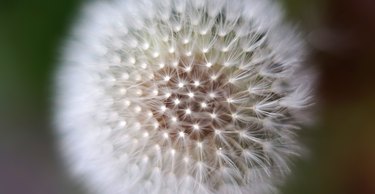
Nearly every adult and child has known the joy of blowing the white fluff off a mature dandelion (Taraxacum, USDA plant hardiness zones 3 to 10). As it ages, this type of dandelion appears as a delicate white fluffy puff at the end of a stem, and it distributes its fuzzy seeds after a puff of air. While dandelions are endless fun for children, they're the bane of many lawn owners' existence. While there are many different types of weeds, species of dandelions are some of the most well-known and the most hated.
Benefits of Dandelion-Type Plants
Video of the Day
Believe it or not, there are more than 250 different species of dandelions, most of which will create dandelion puffs at the end of their life cycle. While lawn culture in today's capitalist world wants you to consider dandelions the enemy, the plant is traditionally known for its medicinal and nutritious properties.
Video of the Day
A dandelion's leaves are edible, and they are a great addition to fresh salads. Dandelion flowers produce generous amounts of nectar to help support honeybees and other endangered pollinators.
The natural vitamins and minerals in dandelions provide vitamins A, B1, B2 and C, and they produce more iron and calcium than spinach. They've been used throughout natural history to treat the liver and urinary issues.
The Life Cycle of a Dandelion
Species of dandelions begin from seeds that are widely dispersed by pollinators, wind and physical distributors, like humans, pets or wild animals. They grow from seedlings into recognizable plants with long, notched leaves between 3 and 10 inches long, which then produce the familiar yellow blossoms.
These flowers stay open for a few days before they begin to turn into feathery bits of fluff that will carry seeds up to 5 miles away from the originating plant.
The Structure of the Dandelion
The yellow dandelion flower we know consists of overlapping, thin yellow petals. Each flower head can produce up to 174 seeds for natural distribution. The seeds themselves come from the center of the blossom. The seed is the mature fruit that results from the pollination of the flower and is called the cypsela.
Attached to each seed is a long, thin stem that leads to a fuzzy-looking parachute structure at the end, which is called a pappus. The pappus is formed as each individual floret from the original flower dries up, leaving the center stem and the residual piece of fluff at the end. The feathery end of the pappus consists of up to 100 small, feathery bristles that act to catch the wind.
The pappus does in fact act as a helicopter or parachute that helps to distribute the seeds via breezes, wind and the breath of fanciful humans. Each of these contains enough force to catch in the fuzzy bristles of the pappus and lift away from the ground. These white floaties can travel miles before settling down on new ground to germinate. In addition to this, this parachute can catch on animals and low-hanging clothing and can spread this way. A single dandelion plant can produce up to 5,000 seeds every year.